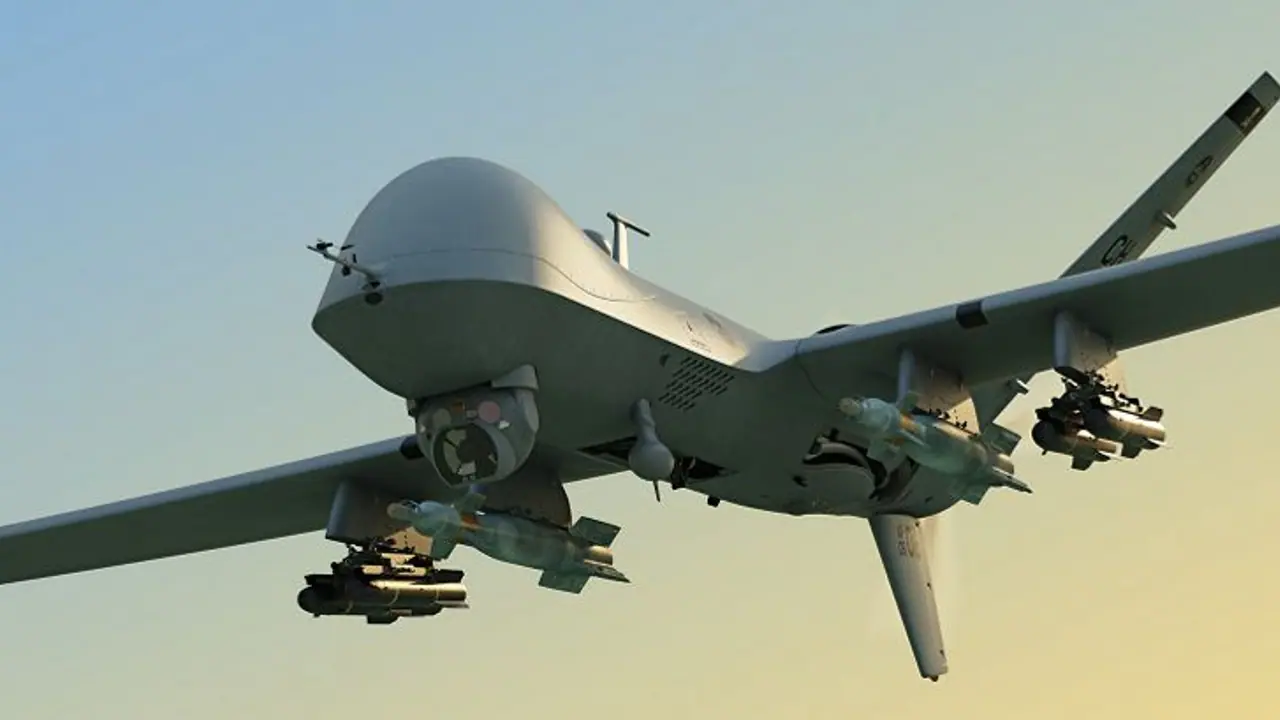The SkyGuardian and SeaGuardian are two variants of the MQ-9B UAV. The MQ-9B Sea Guardian has been used by the Indian Navy for reconnaissance and surveillance in November 2020 following a border standoff with China in eastern Ladakh. Girish Linganna explains
During a meeting of the Defence Acquisition Council chaired by Defence Minister Rajnath Singh on Thursday (Jun 15, 2023), the Defence Ministry reportedly gave its approval for the purchase of US-made MQ-9B Sky Guardian armed drones.

Since November 2020, the Indian Navy has been operating a pair of leased MQ-9B SeaGuardian drones from its Arakkonam Air Station Base in southern India. The lease was extended for at least a year, with both airframes expected to stay operational until December 2022.
India to seek 30 MQ-9B drones from US; deal likely during PM Modi's US visit
In February this year, India’s Hindustan Aeronautics Ltd (HAL), one of the oldest and largest aerospace and defence manufacturers in the world, and General Atomics Aeronautical Systems (GA-ASI), an American energy and defence business, stated that MQ-9B turbo-propeller engines would receive in-country MRO support at HAL’s Engine Division in Bengaluru -- a late confirmation that the final contract now being revealed was in the works.
India will purchase 31 armable MQ-9B Sky Guardian drones from General Atomics. These drones, which are intended for border region monitoring, are anticipated to be distributed equitably among the three Services: eight for the Indian Army, eight for the Indian Air Force, and, perhaps, fifteen for the Indian Navy.
Multiple models of the MQ-9 exist, including the Sea Guardian (MQ-9B), its naval variant, for which the Indian Navy has been contending for the past few years in order to enhance its capabilities -- especially in the light of the expanding Chinese influence in the Indian Ocean Region (IOR) -- and bolster its surveillance apparatus along the frontier with China, as well as in the IOR.
Sky Guardian’s Key Features
General T Michael Moseley, former Chief of the Staff of the US Air Force, has stated that the Unmanned Aerial Vehicle (UAV), also known as the Predator B, is designed to assist the US Air Force in conducting extended surveillance of high-altitude locations, as it can remain in the air for up to 27 hours.
General Atomics, the manufacturer of the Predator B, markets it as a UAV with "unmatched flexibility". General Atomics is developing a Predator with a 40-hour endurance range for the US Marine Corps, which will enhance the UAV’s operational capability. Late in 2023, the aircraft is scheduled to be inducted into the Corps.
The MQ-9B has an operational altitude range of 0 to 50,000 feet and can travel at a maximum speed of 240 knots true airspeed (KTAS), which is the speed of an aircraft connected to the air mass.
Powered by a 950-horsepower (712-kilowatt) engine, the Predator can carry 1,746 kilograms of cargo. It is equipped with precision-guided Hellfire missiles, allowing it to penetrate and strike deep into enemy territory and eliminate high-value targets without involving ground soldiers.
According to the American company, the primary purpose of the UAV is to 'perform multi-mission Intelligence, Surveillance and Reconnaissance (ISR) over land or sea'.
What makes MQ-9B the most lethal military drone?
During former US President George W Bush’s well-known “war on terror” in Afghanistan and Iraq in 2003 following the 9/11 terrorist attacks, these Predator drones were used extensively. They were intended to neutralize anti-US forces and “terrorists” in war-torn nations, but allegations of civilian casualties due to the use of these drones continue to plague the US military leadership.
As recently as on July 31, 2022, Ayman al-Zawahiri, leader of the terrorist outfit Al Qaeda, was killed in a US drone strike in the heart of Kabul, Afghanistan. The MQ-9B drone was used to launch a modified Hellfire missile version to eliminate al-Zawahiri.
Abu Bakr al-Baghdadi, founder of Islamic State (also known as Daesh or ISIS), and Muhammad Atef, military leader of Al Qaeda, were also among the alleged high-profile targets slain by Predator/Reaper drone strikes. Al Qaeda and Daesh are terrorist organizations also outlawed in Russia, India and other countries. Iranian General Qasem Soleimani was also slain by a targeted US drone strike in January 2020.
Earlier, on July 26, 2016, the leader of the Islamic State’s Afghanistan and Pakistan branch was eliminated in a precision drone strike by the US. The death of Hafiz Saeed Khan was a massive blow to the expansionist efforts by the Islamic State to spread out from its heartlands in Syria and Iraq into Afghanistan and Pakistan, already chock-a-block with terrorists and jihadist elements -- including the Al Qaeda and Taliban. It was the second US killing of a prominent militant in the region in months.
Even earlier, on May 21, 2016, Afghan Taliban leader Mullah Akhtar Mansour was killed in a US military drone strike on the N-40 National Highway in Pakistan near the Af-Pak border.
